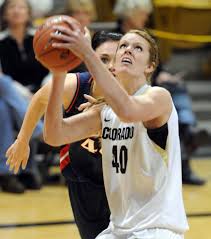Ron Baird, news editor
This user hasn't shared any biographical information
Posts by Ron Baird, news editor

Buffs whip Southern Utah, head to WNIT round three
Mar 23rd
By: B.G. Brooks, Contributing Editor
BOULDER – April approaches and the Colorado women’s basketball team plays on. Arielle Roberson’s second-half scoring and her team’s overall shot blocking swept CU past Southern Utah 79-68 on Saturday night and into the third round of the WNIT.
<script src=”http://player.ooyala.com/player.js?embedCode=J2aThjbDpaUTP8fByOlzPbxh7n5HKTKd&playerBrandingId=88290922e1bd439e9c78d992872b3dd3&width=695&deepLinkEmbedCode=J2aThjbDpaUTP8fByOlzPbxh7n5HKTKd&height=418″></script>
Roberson opened the second half with a 3-pointer, launching the Buffaloes on a 17-5 run that produced their largest lead of the game – 45-26. Held scoreless in the first half, Roberson finished with a team-high 15 points, collected 11 rebounds for her seventh double-double of the season, and added a career-best five of CU’s 14 blocked shots – the second-most in team history.
“That was a tough team we played,” CU coach Linda Lappe said. “Southern Utah does so many good things . . . we had a tough time scoring in first half. Their defense was stingy, but I really liked the way we opened the second half; we had a different level of energy. At the end we were able to do just enough to hold on to our lead and win.”
The Buffs (19-14) defeated the Thunderbirds (23-10) for the second time this season, claiming a 75-59 win in their final non-conference game on Dec. 29, also at the Coors Events Center.
CU’s next WNIT opponent and game site are to be determined. The Buffs advanced with a 78-71 first-round win over TCU, while the Thunderbirds moved into the second round with a 71-56 win over Colorado State.
CU closed Saturday night’s first half with a 12-5 run that produced a 28-21 lead at intermission. Then, the Buffs opened the final 20 minutes with a 17-5 surge to begin pulling away. They led by as many as 19 points but the T-Birds, who never led, closed to within nine points twice in the final 3 minutes. CU hit seven of 10 free throws in the final 1:23 to put the game out of reach.
Roberson said she opened the game “timid . . . I was just going through the motions. It was just a mindset.” She took only two first-half shots, which she said drew a halftime admonishment from associate head coach Jonas Chatterton.
“Coach Jonas was saying ‘shoot the ball,’” Roberson recalled, and in the second half she did. Roberson hit six of her eight field goal attempts. “I just hit the switch,” she said. “In the second half I decided to be myself again and just go out there, be aggressive and play.”
Lappe said Roberson wasn’t “really going, getting touches” in the first half. “She needs our offense to work, to move around her” while she “moves within the offense . . . she was on the receiving end of that (and) stepped up within the flow of the offense.”
Lappe also reiterated Roberson’s thought about her second-half play: “I thought she came out with a different mindset.”
But Roberson had plenty of help. Rachel Hargis tied a career high with 12 points and contributed four steals, while Lexy Kresl added 12 points, six rebounds and four assists. Brittany Wilson was CU’s fourth double-figure scorer with 11 points, while her twin sister Ashley added eight points.
The Buffs went up 6-0 on consecutive 3-pointers by Brittany Wilson and held the lead until the T-birds went to Carli Moreland, a senior from Broomfield. She scored six straight points to pull Southern Utah into a 16-16 tie with 5:42 left before the break.
But that deadlock served as a launch point for the Buffs. They closed the half with a 12-5 run and led 28-21 at intermission, with a catch-and-shoot 3-pointer by Kresl on an in-bounds play at the shot clock buzzer highlighting the surge.
Moreland, meanwhile, got the T-Birds’ final five points of the half, giving her 11 straight. She finished with a game-high 17, with Desiree Harris coming off the bench to add 16.
Roberson had three first-half blocks and got her fourth – setting a career high – in the first minute of the second half. Lappe attributed her team’s 14 blocks to “great help-side” defense, with Roberson adding that communication was a big factor. “I think we did that very well in practice . . . I think it just carried over.”
After Roberson’s trey to open the second-half scoring, Hargis scored on a left-handed spin move and the Buffs were up 33-21, prompting a Southern Utah timeout with 18:22 to play. When the Buffs got one of two free throws from Ashley Wilson and a jumper from Roberson, their lead jumped to 15 (36-21) and the T-Birds were on the ropes.
Lappe called Hargis’ shot “huge. It helped our whole mindset in the second half. Rachel took really good shots and that’s the key . . . she wasn’t in a rush and was just taking her time.”
In scoring 51 second-half points, the Buffs shot 60.7 percent (17-of-28) from the field and finished at 47.9 percent (23-of-48) for the game. The T-Birds scored 27 points off of the Buffs’ 24 turnovers, but CU limited the visitors to 34.5 percent shooting (19-of-55) and held a 21-8 advantage in second-chance points.
That the Buffs are still playing is a large bonus for seniors such as Hargis and the Wilson sisters. “It’s always great to be able to continue to play when other teams are going home and other careers are done,” Hargis said. “We want to play as long as we can; it’s an awesome feeling.”

Pitt Pounds Buffs Out Of NCAA Tourney, 77-48
Mar 20th
By: B.G. Brooks, Contributing Editor
ORLANDO, Fla. – The NCAA Tournament Selection Committee had a slightly higher opinion of Colorado than it did Pittsburgh. The Panthers must have taken it personally, and they took it to the Buffaloes in almost every way imaginable here Thursday.
No. 9 seed Pitt pounded No. 8 seed CU here in the NCAA’s second round, sending the Buffs back to the Rocky Mountains with a crushing 77-48 loss at the Amway Center.
CU made its third consecutive NCAA Tournament trip – a school record – but also made it a second straight “one-and-done” NCAA visit, with Thursday’s 29-point loss the school’s largest ever in NCAA play. The Buffs were eliminated 57-49 by Illinois in last March’s first tourney game in Austin, Texas.
CU dropped to 1-3 in NCAA Tournament competition under fourth-year coach Tad Boyle, but at 23-12 finished the 2013-14 season with the third-highest win total in school history. Yet it might take a while for Boyle to dismiss Thursday’s smack down and reflect on the Buffs’ overall accomplishments this season.
“We’re obviously extremely disappointed with our performance today,” he said. “Credit goes to Pittsburgh; I don’t want to take anything away from them. They’re a great team. They’ve had a great year. They’re good players and (have) a very good coach. But the Buffaloes for some reason or another did not play the way we’re capable of playing. As a coach you take responsibility for that, which I do, but we’re just very disappointed.”
Pitt (26-9) advances to Saturday’s third round, with its likely opponent top-seeded, top-ranked Florida. The Gators were heavy favorites against No. 16 seed Albany later Thursday afternoon. A 16th seed has never defeated a No. 1 seed in NCAA play.
The Buffs never led, never threatened and were never given – or maybe never gave themselves – a chance. Tourney games matching 8-9 seeds can be touch-and-go; this one was take a beating and go home. Pitt controlled the opening tip and everything thereafter.
CU had experienced a few bad first halves this season – both regular-season Arizona losses come immediately to mind – but nothing as horrific on this big a stage. The Wildcats defeated the Buffs twice during the regular season (69-47, 88-61) and eliminated them from the Pac-12 Tournament (63-43).
By intermission, the Panthers led 46-18 and had dealt the Buffs their worst halftime deficit of the season, held them to their lowest first-half point total, their lowest field goal total (five) and harassed the Buffs into 10 turnovers – the second most in a first half this season.
“You go in at halftime down 28, there’s not a lot you can say to your guys positively,” Boyle said. “Other than the fact that we had to come out and compete, that’s what . . . (but) you shouldn’t have to ask your guys to do that.”
Pitt coach Jamie Dixon said his team’s ferocious defensive start “was pretty good, there’s no question about it” and “probably” the Panthers’ best defensive half of the season. “Maybe the North Carolina game early, first half, Wake Forest was very good,” Dixon said. “The good thing is we’re talking about the last week or so, so we’re a better team now than we were earlier in the year. That’s what you hope to be . . .”
CU sophomore guard Xavier Talton said Pitt and CU’s fellow Pac-12 member Arizona were “pretty similar, actually (on defense). I know they were getting to the ball. They were getting 50/50 balls, as well. It just seemed like they wanted it more.”
CU’s 10 first-half errors – 17 for the game – presented Pitt with 12 of its 46 first-half points with another 24 Panthers points coming from inside the paint and 12 more off of fast breaks (14 for the game). Pitt might not have hit as many layups in its pregame drills.
And the afternoon’s final numbers only got worse: At game’s end, Pitt had outscored CU 44-14 in the paint and had converted the Buffs’ 17 turnovers into 24 points.
“We were just trying to set a tone,” said Pitt post Talib Zanna of his team’s early disruptive defense. “The energy, you can tell the energy was there and the focus. The first five minutes we played really good defense, and from there we just tried to get a lot of stops and just run the floor, and we had wide‑open lay‑ups.”
The 6-9, 230-pound Zanna was nothing short of a Nigerian nightmare for the Buffs, accounting for 16 first-half points on 6-of-7 from the field and 4-of-4 from the free throw line. His longest field goal was a 10-foot baseline jumper; otherwise, he was hitting either layups or put-backs and CU’s post defense never found an antidote.
Zanna finished with a game-best 18 points, while Josh Scott led CU with 14. Guards Cameron Wright (11) and Lamar Patterson (10) joined Zanna in double figures. The only other CU player reaching double figures was Xavier Johnson (11). Pitt checked out at 51 percent from the field (31-of-61), CU at 36 percent (15-of-42).
No Buffs player had more than 5 first-half points, and none had an assist – which paled alongside Pitt’s 13. Said Boyle: “I think Pittsburgh is a great passing team. They really move the ball. They come off those ball screens and they make the right decision and they get the ball moved side to side. They get you in rotations.”
CU managed five second-half assists – the same as Pitt – but a final 18-5 discrepancy in assists said as much as anything about the Buffs’ forlorn afternoon.
“You look at our defense, you look at our rebounding, we’re down 15‑8 at halftime on the boards,” Boyle said. “They’re shooting 62 percent and we’ve got zero assists and 10 turnovers. It’s pretty simple. We’ve got to take care of the ball better and we’ve got to guard better and we’ve got to rebound better. We didn’t do any of those things today. I don’t know what Colorado team it was.”
The Panthers held the Buffs scoreless for the first 5:41 and led 13-0 before forward Wes Gordon, watching the shot clock run toward 0:00, hit his fourth 3-pointer of the season. It was a typical CU first-half possession, the best shot CU could get against a Pitt defense that reduced the Buffs’ trips inside to nearly nothing, almost immediately double-teamed Scott and made CU look lost on the perimeter.
“It’s something I’ve had to work on all year, and they were a good defensive team and they rotated out of it,” Scott said. “They covered a lot of space, so credit to them.”
The physical encounter that had been forecast never materialized – at least not for the Buffs. The Panthers, playing their first season in the Atlantic Coast Conference after a long Big East membership, controlled most “50/50” balls and outrebounded the Buffs 33-29 for the game.
Johnson contended Pitt’s physicality didn’t surprise him or his teammates: “No, not at all. We’ve played against some physical teams and I’m a physical player, so I enjoy that.”
Arizona, Johnson said, “is the most physical team I’ve played all year. (Pitt) is big and they’re strong, but no more physical than Arizona.”
The Panthers led by as many 32 points in the second half. With 2:27 to play, Boyle gave his only two seniors – Beau Gamble and Ben Mills – and seldom-used reserve Kevin Nelson their chances for an NCAA Tournament appearance. Gamble hit a 3-pointer from the right corner at the buzzer for the final points of his CU career.
Despite the season’s unsightly end, Boyle said the “future is bright for our program . . . our program is on the assent, it’s not on the descent. We lose two seniors who weren’t in the rotation, terrific young men. But if this can’t motivate our guys going into the off season, for getting in the weight room, working on their game, whether it’s passing, whether it’s dribbling, whether it’s shooting the ball, whether it’s defense, rebounding, toughness, if this can’t motivate them, I don’t know what does.
“But I think it will. I know it will me to become a better coach. I’ve got to help them more offensively so we don’t have five assists and 17 turnovers . . . we’ve shown the defensive aptitude in the past. We didn’t have it (Thursday) for whatever reason.”
Boyle, his staff and their returning players now have a long time to try and figure it out.

CU alumnus heading to the International Space Station
Mar 20th
But this time he will not be riding in the familiar confines of a NASA space shuttle — the fleet was retired in 2011 — but in a capsule atop a Soyuz TMA-12 rocket launching from the Baikonur Cosmodrome in Kazakhstan. Not only will he blast off from there, he is slated to land in the capsule, which is somewhat similar to a NASA Apollo capsule, on the steppe of Kazakhstan in September after spending roughly six months in space.
Swanson, who earned a bachelor’s degree in engineering physics from CU-Boulder in 1983, will serve as flight engineer for Expedition 39, which already will be underway on the ISS when he arrives. In late May, Swanson, who considers Steamboat Springs, Colo., his hometown, will become space station commander as Expedition 40 begins.
Swanson will be launched to the ISS along with cosmonauts Alexander Skvortsov and Oleg Artemyev of the Russian Federal Space Agency.
“We’ve trained extensively and I’m confident I can do all of the tasks assigned to me on the space station,” Swanson said. “The difficult part is being away from my family and friends for a long period. I’ll miss them, but at the same time we will be very busy up there, which makes the time pass quickly.”
The astronaut crew will be involved in dozens of research experiments in the low gravity of the ISS, including efforts related to protein crystal growth, capillary blood flow, gravity sensing by plants and muscle and bone loss changes in space.
As part of his duties, Swanson will operate hardware developed by BioServe Space Technologies located in CU-Boulder’s aerospace engineering department to conduct two experiments on the space station, both being launched later this year. One led by Dr. Timothy Hammond of the Department of Veterans Affairs will use a yeast-based assay system to evaluate known and novel anti-cancer drug therapies in the low gravity of space. A second led by Professor Cheryl Nickerson of Arizona State University will evaluate host-pathogen interactions to better understand the risk of in-flight infections by space explorers during long-term missions.
Swanson previously flew on the STS-17 mission aboard the space shuttle Atlantis to the ISS in June 2007, then flew again on the STS-19 mission aboard Discovery in March 2009. Swanson spacewalked for more than 26 hours during the two missions and is tentatively slated for two more spacewalks during Expedition 39 and Expedition 40.
What does Swanson, whose two shuttle landings were on a smooth NASA runway in Florida, think about drifting by parachute in the Soyuz space capsule on the way from the space station back to Earth, eventually banging onto the ground in Kazakhstan? “I know this landing will be much more wild and exciting than a shuttle landing,” he said. “It is going to be a very different experience, and I’m looking forward to it.”
Swanson will be packing several CU mementos, including a T-shirt, a flag and a small piece of sandstone from the engineering center that has been engraved with a picture of Ralphie the Buffalo and an image of the International Space Station.
What does he recall about his time at CU-Boulder? “I remember waking up and seeing the mountains right there,” he said. “It was a beautiful thing, and helped me get going every day. I really liked CU-Boulder — it is a good school, with good professors — and I love to ski, I love to hike. I like the culture.”
His favorite times on the space station? “One of the best things is when you have a moment to yourself where you can just look out the window,” he said. Swanson also said he will spend what little free time he has emailing with family and friends back on Earth, blogging about his space station experiences and hopefully participating in a Google Hangout, sharing messages and photos and video-chatting with CU-Boulder students.
Eighteen CU-Boulder astronaut-affiliates have flown 47 NASA space missions beginning with Scott Carpenter in 1962.
Former NASA astronaut Jim Voss, who received his master’s degree in aerospace engineering sciences from CU-Boulder in 1974, currently is a CU-Boulder Scholar in Residence. Former NASA astronaut Joe Tanner currently is a senior instructor in aerospace engineering.
To watch a video of Swanson talking about his NASA experiences and his passion for Colorado’s outdoors visit http://www.youtube.com/watch?v=KU53X7O7z7w.
-CU-























